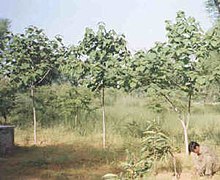Gmelina arborea
| Gmelina arborea | |
|---|---|
 |
|
| Gmelina arborea tree plantation | |
 |
|
| Gmelina arborea sapling from Mindanao, Philippines | |
| Scientific classification | |
| Kingdom: | Plantae |
| (unranked): | Angiosperms |
| (unranked): | Eudicots |
| (unranked): | Asterids |
| Order: | Lamiales |
| Family: | Lamiaceae |
| Genus: | Gmelina |
| Species: | G. arborea |
| Binomial name | |
|
Gmelina arborea Roxb. |
|
| Synonyms | |
|
|
Gmelina arborea, (in English beechwood, gmelina, goomar teak, Kashmir tree, Malay beechwood, white teak, yemane ), locally known as gamhar, is a fast-growing deciduous tree, occurring naturally throughout greater part of India at altitudes up to 1,500 meters. It also occurs naturally in Myanmar, Thailand, Laos, Cambodia, Vietnam, and in southern provinces of China, and has been planted extensively in Sierra Leone, Nigeria, Malaysia, and on experimental basis in other countries as well. It is also planted in gardens and avenues.
Gmelina arborea is a fast-growing tree, which grows on different localities and prefers moist fertile valleys with 750–4500 mm rainfall. It does not thrive on ill-drained soils and remains stunted on dry, sandy or poor soils; drought also reduces it to a shrubby form.
The Gmelina arborea tree attains moderate to large height up to 30 m with girth of 1.2 to 4 a chlorophyll layer just under the outer bark, pale yellow white inside.
Gmelina arborea wood is pale yellow to cream-coloured or pinkish-buff when fresh, turning yellowish brown on exposure and is soft to moderately hard, light to moderately heavy, lustrous when fresh, usually straight to irregular or rarely wavy grained and medium course textured. Flowering takes place during February to April when the tree is more or less leafless whereas fruiting starts from May onwards up to June. The fruit is up to 2.5 cm long, smooth, dark green, turning yellow when ripe and has a fruity smell.
This tree is commonly planted as a garden and an avenue tree; growing in villages along agricultural land and on village community lands and wastelands. It is light demander, tolerant of excessive drought, but moderately frost hardy. It has good capacity to recover from frost injury. Gamhar trees coppices very well with vigorous growth. Saplings and young plants need protection from deer and cattle.
In India, Gmelina arborea occurs extensively from the Ravi eastwards in the sub-Himalayan tracts, common throughout Assam and adjoining areas of northern West Bengal, also in southern Bihar and Odisha, sporadically found in western and southern India and planted elsewhere on a large scale. Gamhar most commonly occurs in West Bengal forests in mixed forests.
...
Wikipedia
